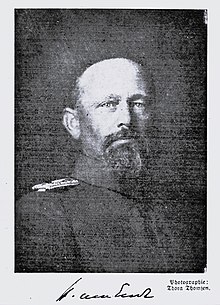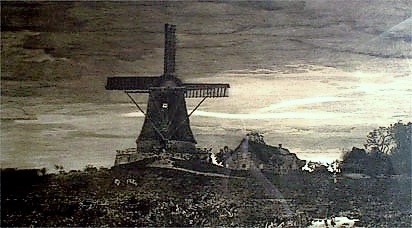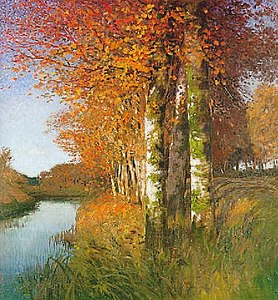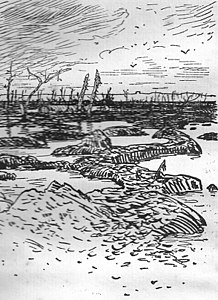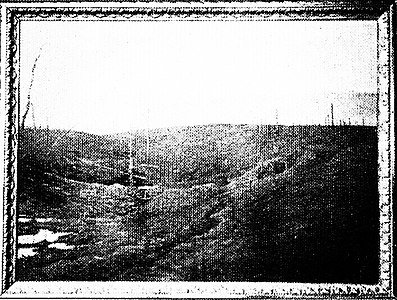Hans at the end
Hans am Ende (* 31 December 1864 in Trier ; † 9 July 1918 in Szczecin ) was a German painter of Impressionism and co-founder of the artists' colony of Worpswede .
biography
Family, education and work
Hans at the end spent his childhood in Trier, where his father Alwin worked as a division preacher. In 1872 the family moved to Kirchscheidungen near Naumburg (Saale) , where his father held the pastoral position until his death in 1888. He obtained his university entrance qualification at the Pforta State School near Bad Kösen . He then studied with Wilhelm von Diez at the Royal Bavarian Academy of Fine Arts in Munich . Here he met his friend Fritz Mackensen , with whom he shared a military service. He then studied at the Grand Ducal Baden Art School in Karlsruhe with Ferdinand Keller before Mackensen was able to persuade him to move to Worpswede . Hans am Ende, like Mackensen and his artist colleagues, wanted in the seclusion of the heather and moor landscape around Worpswede "... to live in harmony with nature and make the rural world the object of their painting." Their decision also represented a protest against the academy of the late 19th century as well as against the civilization of big cities.
Worpswede
In 1889 he settled in Worpswede and was one of the founders of the Worpswede artists' colony alongside Fritz Mackensen, Fritz Overbeck and Otto Modersohn . In 1894 Heinrich Vogeler joined the artists' colony. Hans am Ende built his house and studio, the Buchenhof , next to Heinrich Vogeler's Barkenhoff , which now houses the Heinrich Vogeler Museum. Hans am Ende later married Magda Willatzen, but the happy marriage remained childless.
In 1895 the artists exhibited together in the Bremen art gallery . With an exhibition of the group in the Munich Glass Palace that same year , the artists became known throughout Germany. "Above all, Hans am Ende ... managed to paint a landscape that, with its bright color palette and atmospheric dense image effects, came close to impressionistic imagery."
In the end, landscape paintings convey the image of a cheerful, still intact world. His portraits show his ability "... to grasp and emphasize the inner quality of his models." He made numerous own etchings , some in an extraordinarily large format, and encouraged his painting colleagues to etch.
The poet Rainer Maria Rilke came to Worpswede in 1900 and made friends with the circle of artists. For his monograph Worpswede , planned in 1903 , which was supervised by the Velhagen & Klasing publishing house , he wrote essays on Fritz Mackensen, Otto Modersohn, Fritz Overbeck, Hans am Ende and Heinrich Vogeler. Carl Vinnen could not be persuaded to work together.
Last years
In the First World War , Hans ended up being a captain z. D. reused and served in the infantry regiment "Lübeck" (3rd Hanseatic) No. 162 . Many ink sketches were made during his service on the Western Front .
On April 10, 1918, Hans was seriously wounded at Messines in Belgium and died in the hospital in Stettin. He was buried in Bremen . His gravestone was moved to the Worpswede cemetery after 1945 and placed next to that of his wife.
In the end, the least known of the first Worpswede painters is about Hans. The Kunsthalle Bremen owns several paintings and a collection of his etchings.
Honors
- The Hans-am-Ende-Weg in Worpswede was named after him.
- The Hans-am-Ende-Weg in Bremen- Oberneuland bears his name.
- The Hans-Am-Ende-Straße in Osterholz-Scharmbeck was named after him.
- Works (selection)
- Works (selection)
literature
- Otto Dziobek : History of the Infantry Regiment Lübeck (3rd Hanseatic) No. 162. 1922.
- Rainer Maria Rilke: Complete Works. Volume 1–6, Volume 5. Wiesbaden / Frankfurt am Main 1955–1966.
- Rainer Maria Rilke: Worpswede. Fritz Mackensen, Otto Modersohn, Fritz Overbeck, Hans am Ende, Heinrich Vogeler. 10th edition, Insel, Frankfurt am Main 2007, ISBN 978-3-458-32711-0 .
- Sigrid Welte-Wortmann: The first painters in Worpswede. Worpsweder Verlag, Worpswede 1987, ISBN 3-922516-00-9 .
- Donata Holz: Hans at the end. A Worpswede painter. Publishing house "Atelier im Bauernhaus", Fischerhude 2005, ISBN 3-88132-077-6 .
- Peter Rabenstein: Hans at the end and the Teufelsmoor. In: Heimat-Rundblick , Geschichte, Kultur, Natur ISSN 2191-4257 , No. 96, 1/2011 ( spring 2011 ), Druckerpresse-Verlag , p. 24 f.
- Gudrun Scabell: Worpsweder artist houses. Life on the Weyerberg. Carl Schünemann Verlag, Bremen 2012, ISBN 978-3-7961-1005-4 .
Web links
- Literature by and about Hans at the end in the catalog of the German National Library
- Rainer Maria Rilke on Hans at the end
- Margarete Braun-Ronsdorf: In the end, Hans. In: New German Biography (NDB). Volume 1, Duncker & Humblot, Berlin 1953, ISBN 3-428-00182-6 , p. 246 ( digitized version ).
Individual evidence
- ^ Fritz Nemitz in: Kindler's Painting Lexicon. Zurich 1967, Volume 6, p. 436.
- ^ Biography ( memento from January 15, 2009 in the Internet Archive ) for the exhibition in the Museum of the City of Borna
- ↑ Stefan Lüddemann: Communicate with art. Theories, strategies, case studies. Verlag für Sozialwissenschaften, Wiesbaden 2007, ISBN 978-3-531-15581-4 , p. 78.
- ^ Sigrid Welte-Wortmann: The first painters in Worpswede. P. 84.
- ^ Hans Albrecht Koch: Rilke and Worpswede. Neue Zürcher Zeitung Online, July 26, 2003, accessed on January 19, 2019 .
- ↑ German Officer Association (Ed.): Honor ranking list of the former German Army. ES Mittler & Sohn , Berlin 1926. p. 1026.
- ↑ Otto Dziobek: History of the Infantry Regiment Lübeck (3rd Hanseatic) No. 162. 1922.
| personal data | |
|---|---|
| SURNAME | in the end, Hans |
| BRIEF DESCRIPTION | German painter and graphic artist |
| DATE OF BIRTH | December 31, 1864 |
| PLACE OF BIRTH | trier |
| DATE OF DEATH | July 9, 1918 |
| Place of death | Szczecin |
